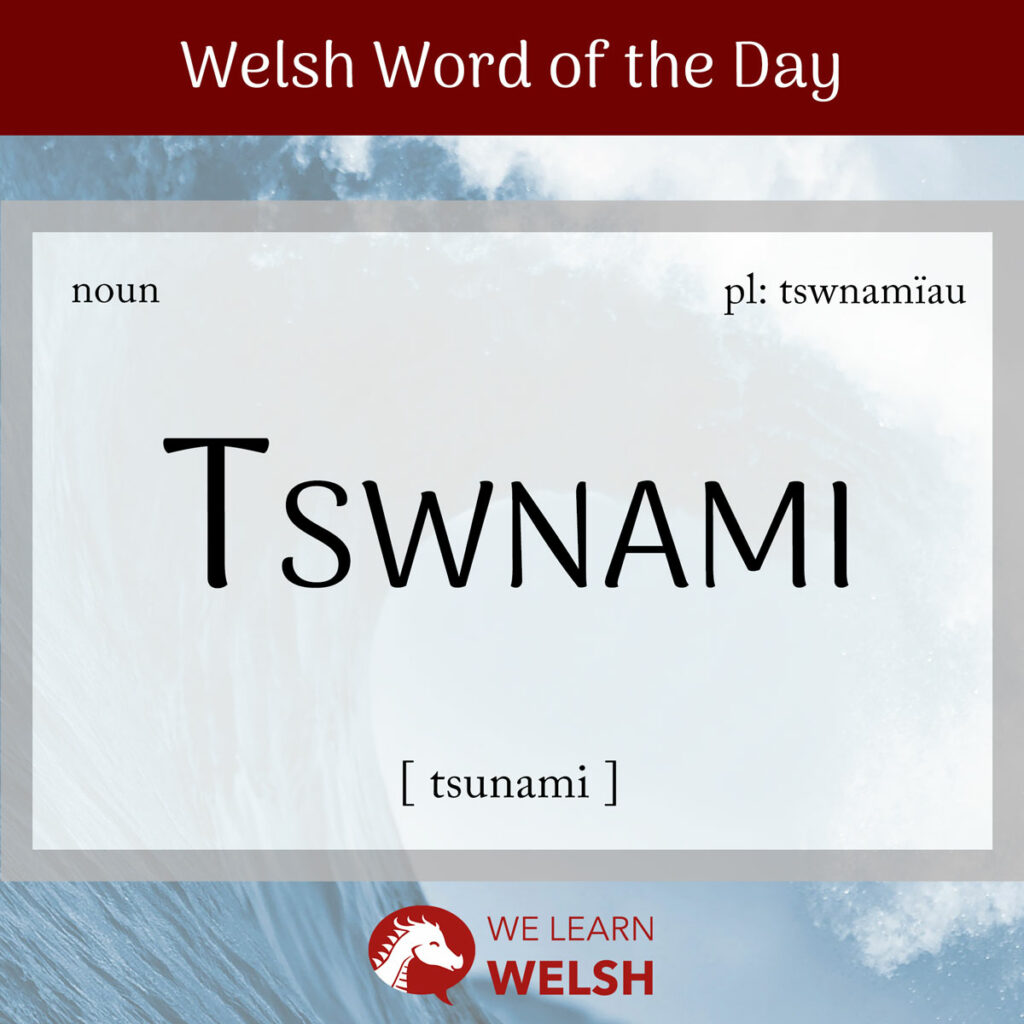Cymru (Wales) isn’t exactly known for extreme tywydd (weather), unless you count an inordinate amount of days of glaw (rain). That’s probably why many of our words for extreme weather phenomena are actually loan words from English or further afield.
One example is tswnami, sometimes spelt swnami… our version of tsunami, if you hadn’t guessed!
Unlike some loan words, it follows a Welsh pluralisation pattern rather than just slapping an s on the end as in English, so multiple tsunamis are called tswnamïau.
tswnami
tsunami
tswnamïau
tsunamis
Another thing that’s different to a lot of loan words is that it doesn’t come from English. Both English and Welsh got the word tsunami / tswnami from Siapaneg (Japanese), where it was originally a portmanteau of the words for porthladd (harbour) and ton (wave).
And the last thing that makes tswnami a stranger to many other loan words in Welsh is that it’s considered a feminine noun, where loan words tend to default to the masculine.
You’d normally expect feminine nouns to take the soft mutation after y, but in fact tswnami isn’t subject to any mutations. This is because, as it comes from Siapaneg, the ts at the start of the word is treated as just one letter, so the word is unable to follow the normal mutation pattern that would go with the letter t.
(In some dialects of Welsh, when spoken informally, the ts sound can soft mutate to j. However this is unlikely to apply to tswnami, given its status as a loan word).
But aside from these small exceptions, you can use the word normally as you would any other Welsh noun.
And I actually think it fits into the Welsh language more naturally than you might expect! The first concert I ever saw was by the Welsh-language band roc (rock band) Sŵnami. Their name is a clever play on the words tswnami and the phrase sŵn a mi (sound and me). It creates the visual impression of a huge ton of sŵn (sound).
A tswnami is either a ton (wave) or a series of tonnau (waves) of maint enfawr (a huge size). They are caused by sudden large symudiadau (movements) in the area, usually under the surface of the môr (sea) at gwely’r môr (the seabed). For example, this symudiadau could be caused by a daeargryn (earthquake) or the eruption of a llosgfynydd (volcano).
They most commonly affect gwledydd ynys (island nations) in or around y Môr Tawel (the Pacific Ocean), like Hawäi (Hawaii) or Siapan (Japan) – this is why the word used in most languages is taken from Siapaneg.
A tswnami is not the same thing as a ton llanw (tidal wave) – something I didn’t even realise until writing this! I thought they were completely synonymous. But actually, the use of the term tidal wave to describe tswnamïau is considered unscientific; a ton llanw is the llanw (tide) surging inwards, as in during a storm (storm), and often causing llifogydd (floods).
Of course, tswnamïau can be incredibly dangerous and destructive. The Tswnami Cefnfor India (Indian Ocean Tsunami) in 2004 killed 230,000 people. In response to this, a new system rhybudd (warning system) was developed in the hope of preventing similar tragedies in future.
Another humanitarian disaster was caused by a tswnami in Siapan in 2011 – but the impact was worsened by the fact that the tswnami triggered malfunctions in gorsafoedd ynni niwclear (nuclear power stations) in the area, sparking conversations about the safety of using this kind of ynni (energy / power).
Trychineb naturiol peryglus iawn yw tswnami.
A tsunami is a very dangerous natural disaster.
Despite the UK being an island, the relatively calm nature of the moroedd that surround it mean that British people are very lucky to be shielded from these kinds of trychinebau (disasters).
In fact, Britain’s greatest natural disaster in hanes (history), occurring in 1609, was a huge llifog (flood) of the Môr Hafren (Bristol Channel), killing around 2000 people, mostly in De Cymru (South Wales). Though it was long believed to have been caused by a tswnami, new scientific evidence suggests that’s unlikely – though historical accounts that describe mynyddoedd (mountains) of dŵr (water) still leave room for doubt.
I feel indeed very lucky to live in a place where the worst the tywydd gets is glaw. But with newid hinsawdd (climate change) causing codi lefel y môr (sea level rise) and an increase in the frequency of extreme tywydd, that may not be the case for long.
Even now, stormydd (storms) and llifogydd (floods) are becoming more and more common and have had serious impacts on people’s cartrefoedd (homes) and busnesau (businesses) in Wales in the last decade or two. It’s a huge concern in particular for a gwlad (country) which relies economically on twristiaeth (tourism) drawn by its natural beauty.
As of right now, Cymru is not at risk of tswnamïau. But unless pobl (people) and llywodraethau (governments) start taking the destruction of Earth’s amgylchedd (environment) more seriously, those of us who live on islands, from Siapan to y Deyrnas Unedig (the United Kingdom), may soon have more to worry about.


